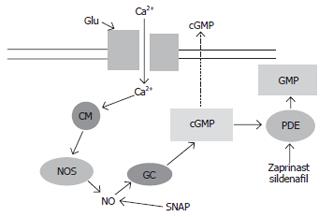Copyright
©2006 Baishideng Publishing Group Co.
World J Gastroenterol. Dec 28, 2006; 12(48): 7737-7743
Published online Dec 28, 2006. doi: 10.3748/wjg.v12.i48.7737
Published online Dec 28, 2006. doi: 10.3748/wjg.v12.i48.7737
Figure 1 Glutamate-nitric oxide-cyclic GMP pathway.
Activation of ionotropic (mainly NMDA) glutamate receptors leads to increased intracellular calcium (Ca2+) which after binding to calmodulin (CM), activates nitric oxide synthase (NOS), leading to increased production of nitric oxide (NO), which in turn activates soluble guanylate cyclase (sGC), resulting in increased formation of cGMP. Part of the cGMP formed is released to the extracellular space. Soluble guanylate cyclase may be also activated by agents that generate NO such as SNAP. cGMP is degraded by phosphodiesterase (PDE) that may be inhibited by zaprinast or sildenafil.
- Citation: Felipo V. Contribution of altered signal transduction associated to glutamate receptors in brain to the neurological alterations of hepatic encephalopathy. World J Gastroenterol 2006; 12(48): 7737-7743
- URL: https://www.wjgnet.com/1007-9327/full/v12/i48/7737.htm
- DOI: https://dx.doi.org/10.3748/wjg.v12.i48.7737









